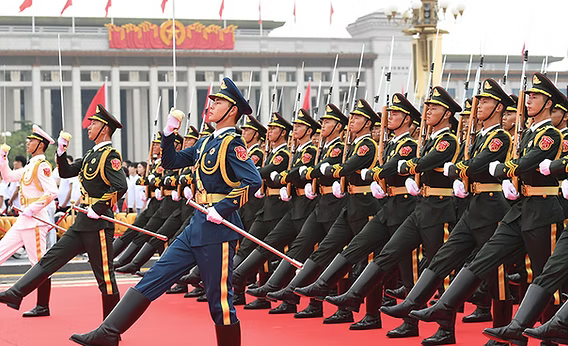
China’s 80th Anniversary Military Parade Signals Escalating Threat to the U.S.
China is preparing to stage a massive military parade in Beijing to mark the 80th anniversary of the end of the Second World War. While officially presented as a commemoration of “victory against fascism,” the spectacle is in reality a political show of force—designed to project military power, stir nationalist sentiment, and signal Beijing’s ambitions to challenge U.S. leadership in global security.
The Chinese Communist Party (CCP) has carefully framed the parade as part of its narrative of being the rightful inheritor of the anti-fascist order. Yet historians note that the CCP played only a marginal role in China’s wartime resistance, compared to the Nationalist government. The “commemoration” is less about history than about rewriting it—using patriotic symbolism to bolster the Party’s legitimacy at home and abroad.
According to Chinese state media and military officials, the event will last 70 minutes and feature 45 marching formations, thousands of troops, over 100 aircraft, and hundreds of armored vehicles. All participating equipment will be current “domestically produced, active-duty” systems.
Highlights include:
Analysts point out that these are not symbols of peace, but explicit tools of intimidation. Several of the systems on display have been engineered with U.S. aircraft carriers, missile defenses, and regional bases in mind.
Official rhetoric emphasizes “anti-hegemonism” and “safeguarding peace.” In practice, however, Beijing uses such language to mask its strategic intent: weakening American alliances and pushing a China-centered global order.
Military officers involved in the parade have described the event as being organized with the precision of a “wartime operation.” This framing underscores its dual function:
For the United States, the parade is more than a ceremonial show—it is a warning. Each missile and drone rolling through Tiananmen Square represents billions of dollars diverted into weapons aimed at reshaping the balance of power in the Pacific.
Key risks for the U.S. include:
The parade sends a clear message: Beijing is willing to use military spectacle as a strategic weapon—testing American resolve and undermining the credibility of U.S. security guarantees in Asia.
Rather than honoring history, this 80th anniversary parade is best understood as a stage-managed political act. It packages China’s military buildup as a patriotic celebration, concealing the regime’s choice to prioritize weapons over social needs.
At a time when millions in China face economic hardship, the CCP is channeling enormous resources into advanced missile systems and warfighting technologies. This contrast highlights the regime’s priorities: control, deterrence, and power projection—not genuine peace.
China’s parade may be staged in Beijing, but its message is aimed squarely at Washington. By showcasing weapons designed to hold U.S. forces at risk, the CCP seeks to alter perceptions of power in the Pacific and beyond.
For Americans, the lesson is clear: Beijing’s displays are not harmless pageantry. They are part of a long-term strategy to challenge U.S. leadership, weaken alliances, and promote an authoritarian alternative to the international order.
Staying vigilant against this military propaganda is essential. Every missile paraded in Tiananmen Square underscores the stakes for U.S. national security and the need to recognize China’s growing willingness to turn history into a weapon—and military might into a political tool.